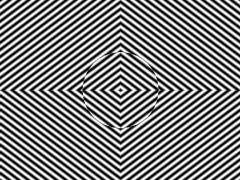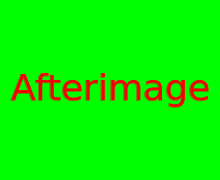Afterimage
An afterimage is a non-specific term that refers to an image continuing to appear in one's vision after the exposure to the original image has ceased. An afterimage may be a normal phenomenon (physiological afterimage) or may be pathological (palinopsia). Illusory palinopsia may be a pathological exaggeration of physiological afterimages.[1][2] The remainder of this article refers to physiological afterimages. A common physiological afterimage is the dim area that seems to float before one's eyes after briefly looking into a light source, such as a camera flash.
Negative afterimages
Negative afterimages are caused when the eye's photoreceptors, primarily known as rods and cones, adapt to overstimulation and lose sensitivity. Newer evidence suggests there is cortical contribution as well.[3] Normally, the overstimulating image is moved to a fresh area of the retina with small eye movements known as microsaccades. However, if the image is large or the eye remains too steady, these small movements are not enough to keep the image constantly moving to fresh parts of the retina. The photoreceptors that are constantly exposed to the same stimulus will eventually exhaust their supply of photopigment, resulting in a decrease in signal to the brain. This phenomenon can be seen when moving from a bright environment to a dim one, like walking indoors on a bright snowy day. These effects are accompanied by neural adaptations in the occipital lobe of the brain that function similar to color balance adjustments in photography. These adaptations attempt to keep vision consistent in dynamic lighting. Viewing a uniform background while these adaptations are still occurring will allow an individual to see the after image because localized areas of vision are still being processed by the brain using adaptations that are no longer needed.
"When all wavelengths stimulate the retinal region adapted to green light, the M and L cones contribute less to the resulting percept because their photopigments absorb less light than the S cones. Thus, trichromatic theory can not explain all afterimage phenomena, indicating the need for an opponent-process theory such as that articulated by Ewald Hering (1878) and further developed by Hurvich and Jameson (1957). Afterimages are the complementary hue of the adapting stimulus and trichromatic theory fails to account for this fact." (David T. Horner, Demonstrations of Color Perception and the Importance of Contours, Handbook for Teaching Introductory Psychology, Volume 2, page 217. Psychology Press, Texas, 2000)[4]
Ewald Hering explained how the brain sees afterimages, in terms of three pairs of primary colors. This opponent process theory states that the human visual system interprets color information by processing signals from cones and rods in an antagonistic manner. The opponent color theory suggests that there are three opponent channels: red versus green, blue versus yellow, and black versus white. Responses to one color of an opponent channel are antagonistic to those to the other color. Therefore, a green image will produce a magenta afterimage. The green color fatigues the green photoreceptors, so they produce a weaker signal. Anything resulting in less green, is interpreted as its paired primary color, which is magenta.
 Example movie which produces distortion illusion after one watches it and looks away. See Motion aftereffect.
Example movie which produces distortion illusion after one watches it and looks away. See Motion aftereffect.
Positive afterimages
Positive afterimages, by contrast, appear the same color as the original image. They are often very brief, lasting less than half a second. The cause of positive afterimages is not well known, but possibly reflects persisting activity in the brain when the retinal photoreceptor cells continue to send neural impulses to the occipital lobe.[5]
A stimulus which elicits a positive image will usually trigger a negative afterimage quickly via the adaptation process. To experience this phenomenon, one can look at a bright source of light and then look away to a dark area, such as by closing the eyes. At first one should see a fading positive afterimage, likely followed by a negative afterimage that may last for much longer. It is also possible to see afterimages of random objects that are not bright, only these last for a split second and go unnoticed by most people.
Afterimage on empty shape
An afterimage in general is an optical illusion that refers to an image continuing to appear after exposure to the original image has ceased. Prolonged viewing of the colored patch induces an afterimage of the complementary color (for example, yellow color induces a bluish afterimage). The "afterimage on empty shape" effect is related to a class of effects referred to as contrast effects.
In this effect, an empty (white) shape is presented on a colored background for several seconds. When the background color disappears (becomes white), an illusionary color similar to the original background is perceived within the shape. The mechanism of the effect is still unclear, and may be produced by one or two of the following mechanisms:
- During the presentation of the empty shape on a colored background, the colored background induces an illusory complementary color ("induced color") inside the empty shape (i.e. bird). After the disappearance of the colored background an afterimage of the "induced color" might appear inside the "empty shape". Thus, the expected color of the shape will be complementary to the "induced color", and therefore similar to the color of the original background.
- After the disappearance of the colored background, an afterimage of the background is induced. This induced color has a complementary color to that of the original background. It is possible that this background afterimage induces simultaneous contrast on the "empty shape". Simultaneous contrast is a psychophysical phenomenon of the change in the appearance of a color (or an achromatic stimulus) caused by the presence of a surrounding average color (or luminance).
Gallery
-
.svg.png)
The US flag inverted
-

The Italian flag inverted
See also
- Palinopsia
- Book of Optics
- Lilac chaser
- Motion aftereffect
- Neural adaptation
- Persistence of vision
- Screen burn-in
- Spectropia
- Visual perception
Notes
- ↑ Bender, MB; Feldman, M; Sobin, AJ (Jun 1968). "Palinopsia.". Brain : a journal of neurology. 91 (2): 321–38. doi:10.1093/brain/91.2.321. PMID 5721933.
- ↑ Gersztenkorn, D; Lee, AG (Jul 2, 2014). "Palinopsia revamped: A systematic review of the literature.". Survey of ophthalmology. 60: 1–35. doi:10.1016/j.survophthal.2014.06.003. PMID 25113609.
- ↑ Shimojo, S; Kamitani, Y; Nishida, S (2001). "Afterimage of perceptually filled-in surface". Science. 293 (5535): 1677–80. doi:10.1126/science.1060161. PMID 11533495.
- ↑ Handbook for Teaching Introductory Psychology - Google Boeken. Books.google.com. Retrieved 2013-09-28.
- ↑ Positive afterimages description
External links
| Wikimedia Commons has media related to Afterimage illusions. |
- The Palinopsia Foundation is dedicated to increasing awareness of palinopsia, to funding research into the causes, prevention and treatments for palinopsia, and to advocating for the needs of individuals with palinopsia and their families.
- Eye On Vision Foundation raises money and awareness for persistent visual conditions
- Afterimages, a small demonstration.
- afterimage examples
- The Color Dove Illusion
